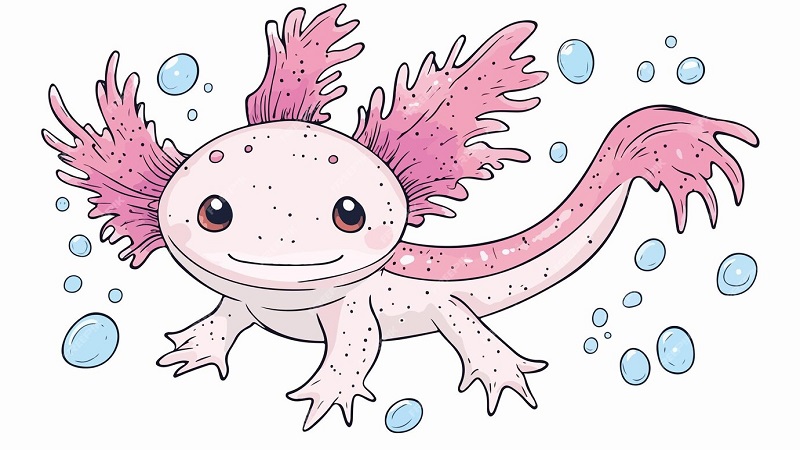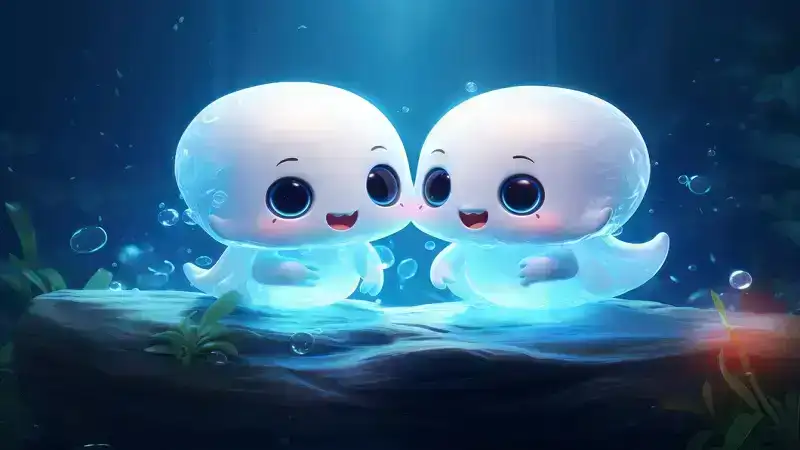If you’ve spent time exploring online communities focused on cute animals, chances are you’ve encountered the axolotl. This quirky amphibian has recently surged in popularity thanks to its distinctive appearance and charming smile. Its wide mouth, baby-like features, and feathery gills have made the axolotl an emblem of cuteness, especially in the context of kawaii culture. The kawaii:dyf8c8wezxm= axolotl encapsulates the essence of everything endearing, and in this article, we will dive deep into what makes this species so special, covering everything from its biology to its impact on modern pop culture.
What is a Kawaii Axolotl?
The axolotl (Ambystoma mexicanum) is a neotenic salamander native to Mexico. Its most distinguishing feature is its ability to retain juvenile traits throughout its life, a phenomenon known as neoteny. While most salamanders undergo metamorphosis, transitioning from aquatic larvae to terrestrial adults, axolotls remain aquatic their entire lives, maintaining gills and a larval appearance. This unique trait, coupled with their “smiling” faces and small, wide bodies, is why thekawaii:dyf8c8wezxm= axolotl is adored by many.
Axolotls have become synonymous with kawaii (the Japanese term for “cute”), thanks to their adorable, almost cartoon-like features. Their wide eyes, pudgy forms, and delicate gills make them stand out as a symbol of charm and playfulness.
Axolotl Origins and Natural Habitat
Axolotls are endemic to a series of lakes in Mexico, primarily Lake Xochimilco. These lakes were once abundant with axolotls, but pollution, urbanization, and the introduction of invasive species have drastically reduced their numbers in the wild. Human activities have critically endangered axolotls, and their natural habitats are shrinking at an alarming rate.
- With short legs and a plump torso, axolotls look like they are constantly ready for hugs (though we don’t recommend touching them).
- The kawaii axolotl perfectly embodies the characteristics that make an animal “kawaii” in Japanese culture, where people cherish and celebrate cuteness.
They are primarily nocturnal and prefer dim environments where they can hunt for worms, small fish, and aquatic insects.
Physical Features That Make the Axolotl So Kawaii
Several unique features contribute to the kawaii= axolotl’s overwhelming cuteness:
- Feathery External Gills: Axolotls have three pairs of external gills that resemble tiny feathery fronds. These gills are not only functional, allowing them to extract oxygen from water, but also give the axolotl a whimsical, fairy-like appearance.
- Wide Smile: Thanks to the structure of their mouths, axolotls look as though they are perpetually smiling. This smiley expression has become a defining trait of their cuteness.
- Big, Beady Eyes: Their round, black eyes are large relative to their heads, enhancing their childlike, innocent look.
- Chubby Body: The soft, squishy appearance of their bodies adds to their appeal.With short legs and a plump torso, axolotls look like they are constantly ready for hugs (though we don’t recommend touching them).
The kawaii axolotl perfectly embodies the characteristics that define “kawaii” in Japanese culture, where people cherish and celebrate cuteness.
Axolotls in Kawaii Culture
Kawaii culture originated in Japan and is centered around things that are adorable, endearing, and sweet. While the axolotl is not native to Japan, its features make it an ideal fit for this aesthetic. In recent years, axolotls have made their way into kawaii merchandise, including plush toys, phone cases, and stationery. Their simple, lovable look makes them the perfect subject for art and design.
In the world of kawaii, the kawaii= axolotl has found a special place, often represented as a cute, smiley character. This transformation into an icon of cuteness has propelled the axolotl into mainstream awareness, especially among young audiences who are drawn to all things cute.
Why Axolotls Are Unique Among Amphibians
Axolotls stand out from other amphibians in many ways. One of their most remarkable traits is their ability to regenerate lost body parts. While some animals can heal from injuries, axolotls can regenerate entire limbs, spinal cords, and even portions of their hearts and brains. This capability makes them a valuable subject for scientific research, as understanding how axolotls regenerate may have implications for human medicine.
Another unique aspect of the kawaii:dyf8c8wezxm= axolotl is its permanent aquatic lifestyle. Most amphibians go through a metamorphic process where they transition from water-dwelling larvae to land-dwelling adults. However, axolotls never leave the water, making them a permanent symbol of adaptability and evolution.
Axolotls as Pets: What You Need to Know
Axolotls have become increasingly popular as pets, thanks to their low-maintenance care needs and, of course, their cuteness. However, it’s essential to understand the proper care requirements for keeping a kawaii:dyf8c8wezxm= axolotl healthy and happy.
Tank Setup
Axolotls need a large tank filled with cool, freshwater. Since they are fully aquatic, a tank with good filtration and regular water changes is necessary to prevent the buildup of harmful chemicals. A temperature between 60-64°F (16-18°C) is ideal, as they do not tolerate warm water well.
Diet
Axolotls are carnivores and primarily eat worms, small fish, and amphibian pellets. It’s important to provide a well-balanced diet and avoid overfeeding to prevent health issues like obesity.
Handling
Axolotls are delicate, and their skin is easily damaged by handling. It’s best to admire your kawaii= axolotl from the outside of the tank and avoid unnecessary contact.
 Axolotls and Conservation: What Being Done to Save Them?
Axolotls and Conservation: What Being Done to Save Them?
Due to their endangered status in the wild, axolotls are the focus of numerous conservation efforts. Scientists and conservationists are working on breeding programs to ensure that the species survives, both in captivity and, hopefully, back in the wild. In Mexico, initiatives are underway to restore the lakes and canals that are the natural habitats of axolotls.
The kawaii= axolotl serves as a symbol of conservation, reminding people of the importance of protecting endangered species. Educational programs in schools and zoos are raising awareness about the axolotl’s plight, helping to garner support for conservation initiatives.
Axolotls in Pop Culture: A Growing Trend
The kawaii= axolotl has recently made waves in pop culture, appearing in video games, TV shows, and social media memes. In games like Minecraft, players can encounter axolotls, adding to their growing fame. They have also appeared in children’s animated shows and as mascots for various brands, further solidifying their status as cultural icons.
This growing presence in pop culture not only boosts the axolotl’s image but also helps raise awareness about its conservation needs. The more people fall in love with these charming creatures, the more likely they are to support efforts to protect them.
The Symbolism of Axolotls in Mythology and Culture
In Aztec mythology, the axolotl is linked to the god Xolotl, who is said to have transformed into an axolotl to avoid being sacrificed. This association with transformation and survival has carried over into modern interpretations of the axolotl, where they symbolize resilience and adaptability.
Their ability to regenerate limbs only reinforces this symbolism, making the kawaii= axolotl a powerful metaphor for recovery and hope.
The Science Behind Axolotl Regeneration
Axolotls’ ability to regenerate body parts has long fascinated scientists. They can grow back entire limbs, including bones, muscles, nerves, and skin, without scarring. Researchers are studying the genetic mechanisms behind this phenomenon in hopes of applying similar techniques to human medicine, particularly in the fields of wound healing and organ regeneration.
The kawaii:dyf8c8wezxm= axolotl is a biological marvel, providing insight into cellular regeneration that could revolutionize how we treat injuries in the future.
Axolotls as Symbols of Hope and Resilience
Because of their ability to regenerate, axolotls have become symbols of hope and renewal. In the face of increasing threats to biodiversity, the kawaii:dyf8c8wezxm= axolotl represents the resilience of nature. Their story is one of survival against the odds, inspiring efforts to save not just axolotls, but all endangered species.
Conclusion: The Endearing Appeal of the Kawaii= Axolotl
The kawaii:dyf8c8wezxm= axolotl is more than just a cute face; it is a symbol of resilience, adaptability, and hope. From its unique biological features to its increasing popularity in kawaii culture and pop culture, the axolotl has captured the hearts of people around the world. Whether you admire them as pets, cultural icons, or symbols of nature’s beauty, there is no denying the enduring charm of these “smiling” amphibians.
FAQs
1. Can axolotls live with other fish?
It’s generally not recommended to house axolotls with fish. Fish may nip at their delicate gills or compete for food, stressing the axolotl.
2. How long do axolotls live?
With proper care, axolotls can live up to 15 years in captivity.
3. What do axolotls eat?
Axolotls primarily eat worms, small fish, and specialized amphibian pellets. Make sure to feed them a varied diet for optimal health.
4. Are axolotls endangered?
Yes, axolotls are critically endangered in the wild due to habitat destruction and pollution, though they are commonly bred in captivity.
5. Why are axolotls considered kawaii?
Their wide smiles, feathery gills, and childlike appearance make axolotls the perfect embodiment of kawaii culture.
